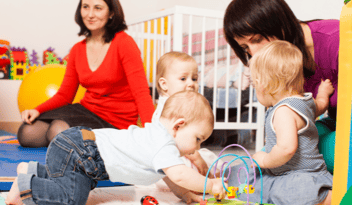Being a parent means your shadow is now a tiny version of yourself that sometimes clings to your legs instead of the pavement.
It means hiding in the closet to eat a candy bar so you don’t have to share, and high-fiving tiny hands that reach under the door to congratulate you when you’re using the potty.
It also means crying the first time you give a big hug around a tiny backpack, and leave to do a preschool drop-off. Check out these expert tips to build a better experience for families that lessens their stress.
The Highs and Lows of Preschool Drop Off
What makes this generation of kids really interesting, is how the pandemic has impacted the relationship between them and their parents. Before we were all plunged head-first into lockdown life, kids were interacting with so many different faces. From grandma and grandpa playing bubbles to the server who waited patiently while they tried to order nachos and ice cream for dinner.
The loss of a village means it now all falls on parents. That’s a heavy weight to carry alone, and one that can have a massive impact on a child’s social and emotional learning.
For these reasons, the pandemic will likely cause preschool drop-offs to become a nightmare in a whole new way. Read on to learn how you can anticipate the new needs of families in ECE, and how to prepare your center for the hardest goodbyes yet.
Table of contents
- Understanding parents at drop off
- Understanding kids at drop off
- Creating a preschool drop-off process that works
- Express Drive Up: A better way to do drop off
Preschool Drop Off: Understanding Parents
To put it bluntly, Starbucks just doesn’t cover it.
As eager as parents may be to drop their little munchkins off at preschool after years of on-again off-again lockdowns, we can expect to see some disappointment and separation anxiety as well.
As schools and offices continue to reopen, we are likely going to see:
Parents who:
- Are scared to drop off children at school again.
- Are burnt out from being primary caregivers, educators, parents, and employees.
- Are a bit more likely to fall under “helicopter” levels of parenting
Kids who:
- Don’t understand why they can’t stay home and wave to coworkers on Zoom calls anymore.
- Pick up on parental stress during pickup and drop off
- Don’t understand how to say goodbye to mom and dad, since they’ve never left them before
- Have never trusted another adult outside of their parents
For the past two years, parents have worn the hats of educators, primary caregivers, and the occasional space alien who’s fighting monsters in between filling out spreadsheets. 👽
We’ve seen kids bond with their primary caregivers in a way we’ve never experienced before. No matter which way you look at it, the shutdown transformed the dynamic between parents and kids.
This year, we can expect a preschool drop-off to be full of emotions on both sides.

Perfecting parent communication around drop-offs
Throughout the shutdowns, many parents have been forced to take on the role of educators.
For some families, this may be an eye-opening experience of what teachers go through every day. Parents are coming out with more appreciation for teachers, but also, with a greater understanding of their own child’s needs.
We may see this new understanding intertwine with separation anxiety, making parent-teacher communication a top-tier priority this year.
Understanding a parent’s need to communicate closely around their child’s day will help build confidence at drop-off and set the tone for healthy parent involvement throughout the school year.
Here are some ways to improve communication with parents:
- Ask teachers and staff to regularly send photos of the child enjoying the day.
- Have a great parent portal that’s easy to use.
- Encourage parents to participate in conversations around goals for their child.
- Have frequent family nights (even if they’re virtual 😉).
And last but not least, ditch the paperwork. It’s no secret millennial parents tend to lean more towards digital communication, but also consider that parents have enough on their plate, it’s hard to remember physical forms that need to be filled out.
Papers get crumpled, chewed on, and lost. A simple child care app or even email update can make the process much easier for everyone.
Already a LineLeader user? With a single tap of the app, parents can use Express Drive Up to update their ETA and let teachers know they’re on the way!
Easing separation anxiety and health and safety anxiety
It’s understandable that some parents will feel a level of anxiety returning a child to school.
Psychologically speaking, there is a wide variety of reactions a person may have to a situation they have no control over. When it comes to the pandemic, the data just isn’t there for parents to make informed choices. And yet, in the age of the internet, parents are getting information thrown at them from all different angles.
We’ve definitely been seeing families on both sides of the spectrum when it comes to things like mask-wearing and sanitization in the classroom. While you will never be able to make every single family happy with your approach to tackling the pandemic, making parents feel safe dropping their child off will help the process, and prevent kids from picking up on any anxiety.
Here are some ways to help ease that anxiety at drop-off:
Listen to parent concerns (even if you can’t apply them).
Tell parents what to expect before it happens:
- What happens if there’s a positive case?
- What happens if schools have to shut down again?
- Encourage parent-child conversations about the pandemic
Share your safety plan and actively update as adjustments are made
Addressing parental guilt at child care drop-offs
Let’s take a moment of silence for all the parents who have been personally victimized by Cammie the soccer mom. 😔
In the past, parental guilt stemmed from judgmental comments, often coming from other parents. If you aren't making homemade dog food using the scraps from the organic lunch you made your two-year-old, Cammie (or someone like her) is going to have things to say.
This year, parental guilt goes far beyond forgetting show and tell, or dropping the kids off in pajama pants — and there is still so much we don’t know about Covid-19.
Throw one bad morning into the mix, and it’s easy to see how the simple act of dropping off your child at preschool can quickly turn into a nightmare scenario for overwhelmed parents.
Here are some ways to use drop-off as an opportunity to remind parents how awesome they’re doing:
Reinforce parents on their child’s progress since they’ve been out of school.
A simple “good job keeping them alive” goes a long way.
Tell them point-blank “You’re not messing them up.”
- Show parents all the milestones their child is hitting.
- Share the smiles the child is showing day to day.
- Highlight how much they’re enjoying being a kid.
Share educational resources:
- About how children are responding to mask wearing.
- About your local guidelines on COVID recommendations and how you’re following them.
- About developmental milestones their child should be hitting, and what’s normal to be behind on right now.
- Remind them of the benefits of child care.
Preschool Drop Off: Understanding kids
When it comes to young kids and preschool drop offs, we all know how it goes.
The waterworks come on the moment their parent heads for the door, and stop the second they leave. For reasons already mentioned, drop offs may be even harder on children than we’ve seen in the past.
How to establish trust with post-pandemic kids
Even first-year students tend to have had days or nights away via the occasional babysitter.
But the pandemic has caused many parents of infants and young children to feel less comfortable leaving a child with a sitter. More time balancing work and kids has left less time and energy to leave kids for a night off. This means, kids will be entering care with less understanding of how to trust unfamiliar adults taking care of them, making drop offs more scary.
Here are a few ways to build trust with 'Gen C' kids:
- Let them see positive interactions between teachers and parents
- Allow them to carry a security object
- Encourage introductions prior to starting school
- Consider a trial day
- Make the day fun
Helping kids ease back into a routine
Prior to the pandemic, it was easier to keep kids in a daily routine.
Parents needed to be at the office at a specific time, making for consistent wake-up and bedtime schedules. These days, many kids no longer have a consistent schedule, making the transition into child care harder than ever.
When kids feel disrupted just being at school, it can make drop-offs feel even more daunting. These simple steps can help make it easier to ease them back into the classroom:
- Share your classroom’s routine with parents prior to enrollment, and encourage them to get closer to the same schedule.
- Keep parental communication strong to bridge consistency with classroom activities and home activities.
- Understand kids are going to be more tired during the day, causing more behavioral disruptions.
Keep your preschool drop-offs fun for kids
With kids being out of school for so long, it’s easy to put pressure on the curriculum to get them back on track for elementary school.
But it’s important to remember that kids have also had to sacrifice things like going to the park and having playdates with friends. Helping kids enjoy being at school will naturally make drop-offs more exciting for them, and build confidence in parents.
- Encourage a play-based curriculum.
- Provide teachers with extra education on developing friendships in the classroom.
- Set realistic expectations on milestones with parents who may be anxious about their child falling behind.
Creating a preschool drop-off process that works
You already know drop-off is one of the most hectic times of the day.
Between teachers getting classrooms ready, kids crying as parents leave, and parents and teachers struggling to communicate all that needs to be said in a matter of minutes — things can get chaotic fast.
A streamlined system for drop-off can make the entire day run smoother for everyone. The following video shows how we tackle this problem in LineLeader using our simple, parent-friendly Express Drive-Up feature. Or, you can skip ahead to the following five-step process for easier mornings. 🙌🏽
Step 1: Get kids excited
Creating an environment where kids are excited to go to school is the first step in keeping the drop off experience stress-free. Taking steps to make sure students enjoy school early also paves the way for a better relationship with education long-term.
Here are some ways to get kids excited to go to school:
- Send parents something like “jitter glitter”, a bag of glitter to put under a child’s pillow the night before school to ease their nerves.
- (Hint: You can send some home for nervous parents too!)
- Have kids talk with parents the night before about what they’re going to do in class the next day.
- You can even send home conversation prompts so parents know what to talk about.
Step 2: A better start
Getting children prepared for learning starts before drop off.
It is so important for parents to understand how their own morning routines can impact the rest of their child’s day. While there’s not always much you can do to help children prior to entering the classroom, you can empower parents with the tools to encourage a better start to the day.
Helping parents get their child ready for drop off:
- Sleep Habits: We all get crabby when we’re tired, especially kids. While we can’t do much to get kids to bed on time, we can empower teachers to notice when kids may need more sleep at home.
- Monitor nap times and note children who may be more tired during the day
- Have conversations with parents around sleep routines to help kids feel less tired
- Most Important Meal of the Day: Kids get hangry. Mornings get hectic. Some parents have a difficult time getting meals ready before heading out the door.
- Consider providing an opportunity for children to eat at school if they missed breakfast at home.
- Have a game plan around communication with parents and food allergies in case kids in the classroom need an extra snack
Step 3: Settling in
Getting a toddler to get dressed is an event.
Watching three-year-olds struggle to put on gym shoes in the morning when you’re already running behind is somehow even more frustrating than being stuck in rush hour traffic. While we can’t force parents to get to class early to help kids settle in, there are things we can do to help ease the tension.
Filling the gaps of rough mornings at home:
If possible, encourage parents to stay for a few minutes while their child settles into an activity.
- This makes it easier to say goodbye.
- It also encourages confidence when the parents need to leave, allowing them to have a better day.
- Finally, it helps get the child ready to learn.
Empower teachers with tools to streamline their own mornings.
- This allows more time to communicate with parents.
- Give teachers buffer time to help kids settle in.
- Provides an opportunity for teachers to learn about what to expect from the child, and what may be happening at home.
Create an environment with happy teachers.
- Calm, happy teachers can offset anxiety kids are feeling due to the pressure of being on-time in the morning.
- Parents will pick up on how your teachers are feeling, and kids will feed off their confidence.
Step 4: Saying goodbye
There’s no doubt we’ll be seeing some increased separation anxiety in both parents and kids during drop offs.
Luckily, there are steps you can take while creating your preschool drop off plans that will ease the anxiety for everyone.
A better drop off:
Encourage quick, swift goodbyes when parents leave.
- Ensure the parent feels confident prior to leaving.
- Have parents wave from the window if it helps the child.
- Encourage parents to not reenter the classroom, and to drop forgotten items off at the office to prevent confusion.
Encourage positivity with parents and kids.
- Remind teachers to keep a consistently positive tone.
- Point out happy kids to children who are struggling, as a reminder that this is a fun place to be.
Step 5: Setting up for continuing success
Finally, the great news is there are things you can do in your child care center immediately post-drop-off to encourage mornings that continue to get better over time.
Helping kids and parents transition faster:
Create morning routines so the children know what to expect.
Have mornings start the same way each day (snack is a great way to start!)
Ask teachers to send parents a photo 10 minutes after drop off.
- This helps ease anxiety if a child was emotional at drop off
- It also helps build confidence for drop-off the next day
Advise teachers to send parents weekly emails detailing how a child’s week went
- This keeps parents in-the-loop
- And builds confidence that your center is on top of things
Provide a better way for parents and teachers to communicate throughout the day
Make Preschool Drop Offs Easier with LineLeader
Decreasing the transition period a child goes through while getting used to a new preschool or child care center is going to be more important than ever post-pandemic.
Luckily, the right tools can help.
With the Express Drive Up feature in LineLeader by ChildcareCRM, parents can let teachers know their child’s physical and emotional state when heading into the center, and even update their ETA with a simple tap.
Teachers and staff no longer need to guess who’s going to arrive on time, or who will need an extra cuddle at drop-off. Now they have everything they need to stay close to parents and kids at one of the most hectic times of day.
When you’re ready for an easier drop-off experience, LineLeader can help.
Not a User Yet?
Schedule a demo to see LineLeader in action.
Already a User or Simply Want to Learn More?
Download the benchmark report to expertly grow and manage your childcare business.





